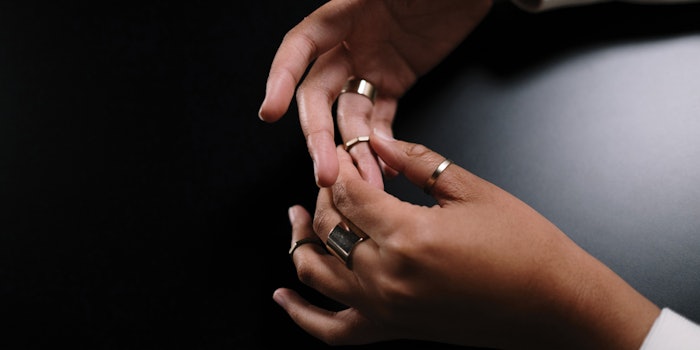
Have you spotted a nail at your station with a Christmas tree-type pattern: a center split that extends from the cuticle to the free edge, with multiple irregular cracks along both sides of the split? If so, your client may have median nail dystrophy (MND) caused by picking at the nail, according to Ross Radusky, MD, board-certified dermatologist at The Derm Group in Morristown, New Jersey. “Look for nails that have an unusual shape to them—think sharp lines and angles with haphazard depressions and thickenings,” he advises. “Because the culprit is external, the body will not produce the typically more symmetric deformity seen in other conditions.”
Indeed, Chris G. Adigun, MD, FAAD, a board-certified dermatologist with the Dermatology & Laser Center of Chapel Hill in Chapel Hill, North Carolina, calls most cases of MND an “outside job,” that is, initiated by picking, most often affecting the thumbnail. “The visible portion of the nail matrix (the moon) is more visible—and therefore more vulnerable—on the thumbs, compared to the other digits,” Dr. Adigun explains. “When someone chronically pushes back or picks at the cuticle, the nail matrix (which is what forms the nail) can become disrupted. It’s that disruption in the middle of the nail that leads to MND.” Dr. Adigun adds that most nail techs have probably seen MND before. Externally caused, it’s pretty common. However, though rare, there are also cases that present without a history of picking.
Underlying Causes
For those rare cases that are not related to picking, Shari Lipner, MD, PhD, associate professor of clinical dermatology and director of the nail division at Weill Cornell Medicine in New York, notes that MND has a variety of causes, both benign and malignant. “It generally affects one nail, but may affect more than one, and, in general, MND involving more than one nail is usually benign,” Dr. Lipner notes. “Benign causes include trauma, a myxoid cyst and onychopapilloma (a rare benign tumor). Benign causes of MND can present at any age, but patients with myxoid cysts often have a history of osteoarthritis and tend to be older.” Meanwhile, malignant causes of MND may be squamous cell carcinoma or subungual melanoma—nail cancers that are also more often present inolder adults.
Therefore, Dr. Radusky makes a distinction between MND and habit tic deformity (HTD) nails, which are caused by picking. Though they look very similar, they are not considered the same condition. “MND is a rare disorder of the fingernails—most commonly, both thumbs,” Dr. Radusky explains. “The causes of MND are unknown, though some have been linked to medications, like isotretinoin (Accutane) and certainHIV medications.”
HTD nails look very similar, but the most important difference is the source of the problem: Cases of HTD are always caused by trauma. “The skin and the nails respond the same way to pressure—they thicken,” Dr. Radusky says. “Chronic rubbing or picking at the nail (most commonly, the thumbnail) thickens the nail plate, leading to the irregular texture.” Clients may rub or pick their nails for a variety of reasons; the action may be due to a compulsion, or may stem from work, sports or hobbies (such as repetitive keystrokes on a phone or computer, orplaying guitar).
Salon Spotting
If you come across a client with MND or HTD nails at the salon, you can take several steps to help—and should definitely avoid certain procedures. First, Dr. Radusky notes that nail techs can help identify HTD-related trauma by being on the lookout: Does the client rub her nail or press on one nail with her phone or other fingers? “Be a quiet observer—and if you do notice something, it’s best to confront the person in a nonjudgmental manner,” Dr. Radusky recommends. “She may not know that her actions are causing damage to the nail. And, if you’re unsure about any nail issue, it’s always best to recommend a visit to a board-certified dermatologist.”
To read the full article, check out Nailpro's March/April digital magazine.
Tracy Morin is a freelance writer and editor based in Oxford, MS.












